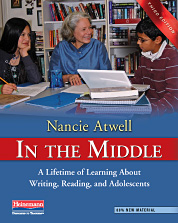The Writing Conference in Nancie Atwell’s Room (Part 3)
By Donald LaBranche
This post is the third in a series of reviews of In The Middle, by Nanci Atwell, Third Edition, 2015. Click here to see the previous reviews.
 Here’s the first verse from Robert Bly’s poem “Things to Think”
Here’s the first verse from Robert Bly’s poem “Things to Think”
Think in ways you’ve never thought before
If the phone rings, think of it as carrying a message
Larger than anything you’ve ever heard,
Vaster than a hundred lines of Yeats.
When the best teacher in the world is a middle school English teacher, folks who do the same thing for a living might want to sit up and pay attention. When she has written book after book for decades telling us how to avoid becoming mere “technicians” and hold true to what is best in the teaching profession we might ask, “Have I heard what Nanci Atwell has to say?” and if the answer is no, then ask, “Why not?” Read more




